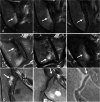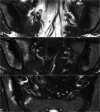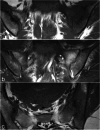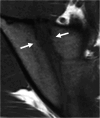When it is not sacroiliitis
- PMID: 40461872
- PMCID: PMC12460383
- DOI: 10.1007/s00256-025-04958-7
When it is not sacroiliitis
Abstract
Magnetic resonance imaging of the sacroiliac joints (SIJ) is now frequently performed to detect subchondral inflammatory and structural changes in patients with early axial spondyloarthritis (SpA). However, similar changes can also occur in various other conditions, which may lead to the overdiagnosis of axial SpA. The aim of this article is to review the key imaging features of the most common disorders that may mimic inflammatory sacroiliitis, including mechanical changes and osteoarthritis, osteitis condensans ilii and pregnancy-related changes, other strain related changes, anatomical variants, pediatric SIJs, hyperostosis, infectious sacroiliitis, SAPHO syndrome, hyperparathyroidism, and sacral stress fractures.
Keywords: MRI; Osteoarthritis; Sacroiliac joint; Sacroiliitis; Spondyloarthritis.
© 2025. The Author(s).
Conflict of interest statement
Declarations. Ethics approval and consent to participate: Not applicable. Competing interest: The authors declare no competing interests.
Figures










References
-
- Rudwaleit M, Jurik AG, Hermann KGA, Landewé R, Van Der Heijde D, Baraliakos X, et al. Defining active sacroiliitis on magnetic resonance imaging (MRI) for classification of axial spondyloarthritis: a consensual approach by the ASAS/OMERACT MRI group. Ann Rheum Dis. 2009;68(10):1520–7. - PubMed
-
- Lambert RGW, Bakker PAC, Van Der Heijde D, Weber U, Rudwaleit M, Hermann KGA, et al. Defining active sacroiliitis on MRI for classification of axial spondyloarthritis: update by the ASAS MRI working group. Ann Rheum Dis. 2016;75(11):1958–63. - PubMed
-
- Maksymowych WP, Lambert RG, Østergaard M, Pedersen SJ, Machado PM, Weber U, et al. MRI lesions in the sacroiliac joints of patients with spondyloarthritis: an update of definitions and validation by the ASAS MRI working group. Ann Rheum Dis. 2019;78(11):1550–8. - PubMed
-
- Rennie WJ, Cotten A, Jurik AG, Lecouvet F, Jans L, Omoumi P, et al. Standardized reporting of spine and sacroiliac joints in axial spondyloarthritis MRI: from the ESSR-Arthritis Subcommittee. Eur Radiol. 2024;35(1):360–9. - PubMed
-
- Carneiro BC, Rizzetto TA, Silva FD, Da Cruz IAN, Guimarães JB, Ormond Filho AG, et al. Sacroiliac joint beyond sacroiliitis—further insights and old concepts on magnetic resonance imaging. Skeletal Radiol. 2022;51(10):1923–35. - PubMed
Publication types
MeSH terms
LinkOut - more resources
Full Text Sources
Medical

